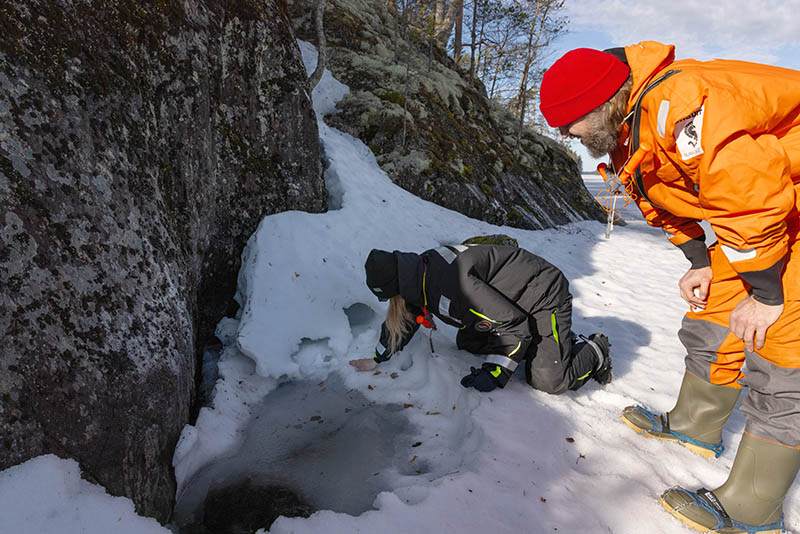The Saimaa ringed seal population has continued to grow, despite recent winters being exceptionally mild and low in snow. According to the population estimate published by Metsähallitus on 27 October 2025, the estimated population for 2025 is 530 individuals. In 2024, the corresponding figure was 495. The population is growing rapidly in Puruvesi and southern Lake Saimaa, while the situation in northern Saimaa is concerning.

The population estimate reflects the number of individuals in January of the given year and does not include pups born in the spring. It is an expert assessment based on lair count results and supplemented with various monitoring data.
In addition to the estimate, the number of pups born also indicates growth. In 2025, 114 pups were born, compared to around 80 annually ten years ago. However, due to poor breeding habitat conditions caused by mild winters and a lack of natural snowdrifts, pup mortality has been high. In 2025, mortality was 19 percent, and in 2024 it was 21 percent, whereas under favorable conditions it is typically around 10 percent.
As climate change progresses, breeding habitat conditions are increasingly poor.
“Last winter was very mild and low in snow. As a result, most man-made snowdrifts and artificial nests were used, and 85 percent of observed pups used them for shelter. Without these, pup mortality would have been even higher. In addition to degraded breeding habitats, unintentional bycatch in fishing gear causes additional mortality among young individuals,” says Riikka Alakoski, Senior Conservation Specialist at Metsähallitus Parks & Wildlife Finland.
Fishing restrictions also provide vital protection
In 2025, 45 dead Saimaa ringed seals have already been found. Of these, 21 were pups found dead at lair sites before weaning, eight had died in fishing gear, and the rest were other deceased individuals, some of whose causes of death are being investigated through autopsies at the Finnish Food Authority.
Fishing restrictions have proven to be an effective way to protect the Saimaa ringed seal. The expansion of restricted areas since the 2010s has enabled more seals to reach reproductive age, which is reflected in the increasing number of pups born.
“Bycatch mortality remains a significant cause of additional deaths, slowing population recovery. Most seals deaths caused by gill nets occur after the seasonal gill net ban ends at the end of June, with mortality peaking between July and September– nets pose a danger throughout the year” says Miina Auttila, Senior Conservation Specialist at Metsähallitus Parks & Wildlife Finland.
Regional differences in the seal population
In Pihlajavesi, the population continued to grow steadily, with 40 percent of pups born in the area. It is likely that individuals have also moved from Pihlajavesi to Puruvesi. In both Puruvesi and southern Suur-Saimaa, the population is growing rapidly, and a record number of pups were observed in both areas. The first Saimaa ringed seal pups were born in these areas only in the 2000s – regions where human activity had previously wiped out the seal population.
Metsähallitus’ lair density map (in Finnish) shows that breeding areas have expanded, especially in Puruvesi and southern Suur-Saimaa. In areas with denser populations, movement during the breeding season increases the risk of disturbance.
“The situation is worrying in northern Lake Saimaa, particularly in the Pyhäselkä–Jänisselkä area, where no pups have been born for three years. In neighbouring Orivesi, only one pup has been observed annually. However, seals are still sighted in the area every year, even as far as the Joensuu region,” says Miina Auttila.
Metsähallitus is responsible for monitoring the Saimaa ringed seal population and for many of the protection measures. Over 300 local volunteers participate annually in monitoring and conservation activities, such as lair counting and making man-made snowdrifts.
Fishing restrictions under review
The Government Decree on certain fishing restrictions in Lake Saimaa is currently being updated. As part of the update process, a public survey has been launched. In addition, the North Savo ELY Centre will organise four public regional events in November.
- Public survey on Saimaa ringed seal protection and fishing (forms.office.com, in Finnish)
- Discussion events on reconciling seal protection and fishing – ELY Centre (ely-keskus.fi, in Finnish)
More Information
- Population monitoring: Metsähallitus, Parks & Wildlife Finland – Miina Auttila, Senior Conservation Specialist, tel. +358 40 637 6324, miina.auttila@metsa.fi
- Nest counts, artificial snowdrifts and carcasses: Metsähallitus, Parks & Wildlife Finland – Riikka Alakoski, Senior Conservation Specialist, tel. +358 40 530 7241, riikka.alakoski@metsa.fi
- Saimaa ringed seal
- Public survey on Saimaa ringed seal protection and fishing (forms.office.com, in Finnish)
- Discussion events on reconciling seal protection and fishing – ELY Centre (ely-keskus.fi, in Finnish)
The attached table shows the birth rate for 2025 and an estimate of the winter population size by monitoring area. Population estimates from previous years are available in the Norppatilanne service (in Finnish). Location of monitoring areas in Saimaa (pdf, 2 MB).
| Water area | Pups confirmed | Pups estimated | Estimated winter population |
|---|---|---|---|
| Pyhäselkä–Jänisselkä | 0 | 0 | 7 |
| Orivesi | 1 | 1 | 12 |
| Pyyvesi–Enonvesi | 2 | 2 | 10 |
| Kolovesi | 2 | 2 | 16 |
| Joutenvesi | 5 | 5 | 31 |
| Haukivesi | 21 | 21 | 101 |
| Pihlajavesi | 45 | 45 | 180 |
| Puruvesi | 6 | 6 | 21 |
| Tolvanselkä–Katosselkä | 9 | 9 | 49 |
| Luonteri | 2 | 4 | 17 |
| Lietvesi | 5 | 5 | 25 |
| Petraselkä–Yövesi | 7 | 7 | 40 |
| Suur-Saimaa | 7 | 7 | 21 |
| Total | 112 | 114 | 530 |